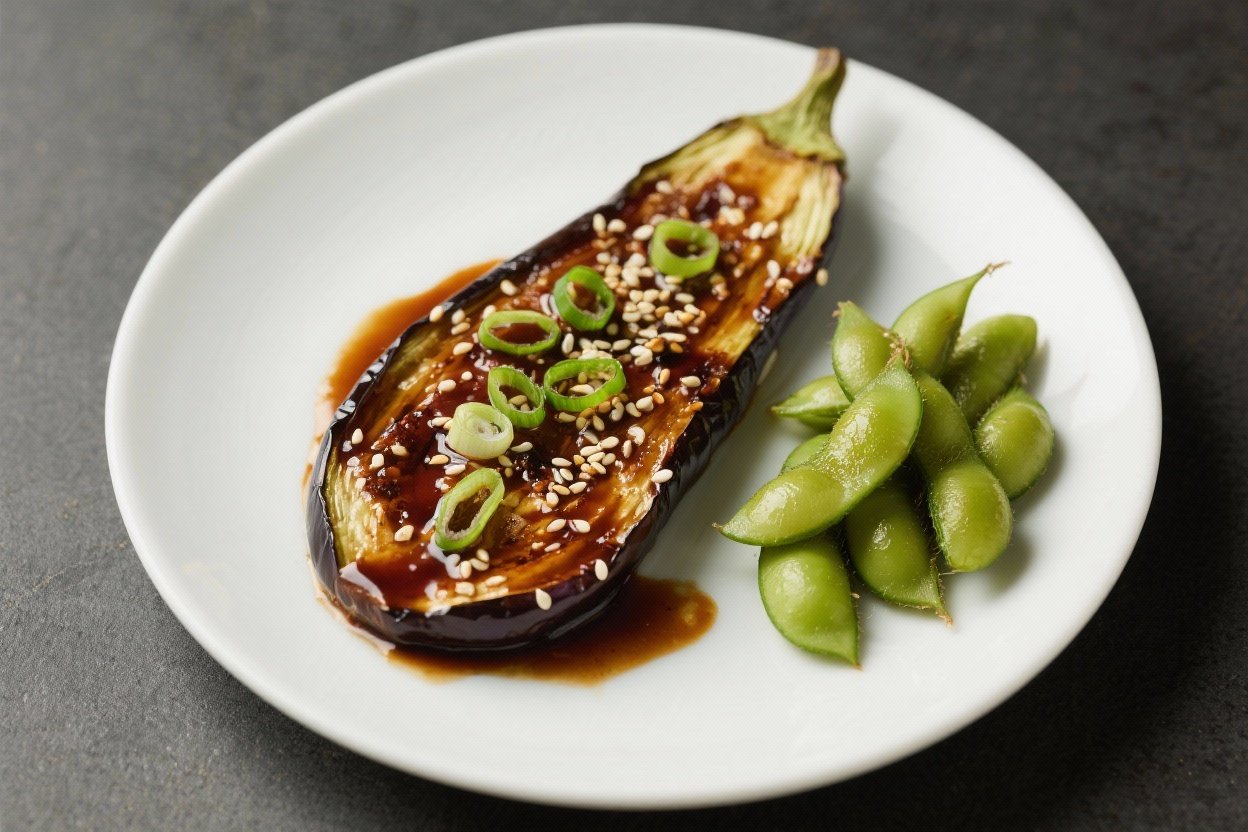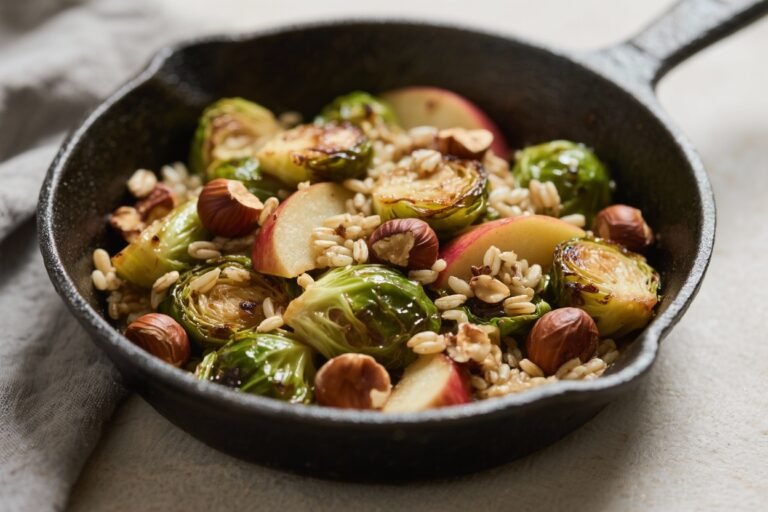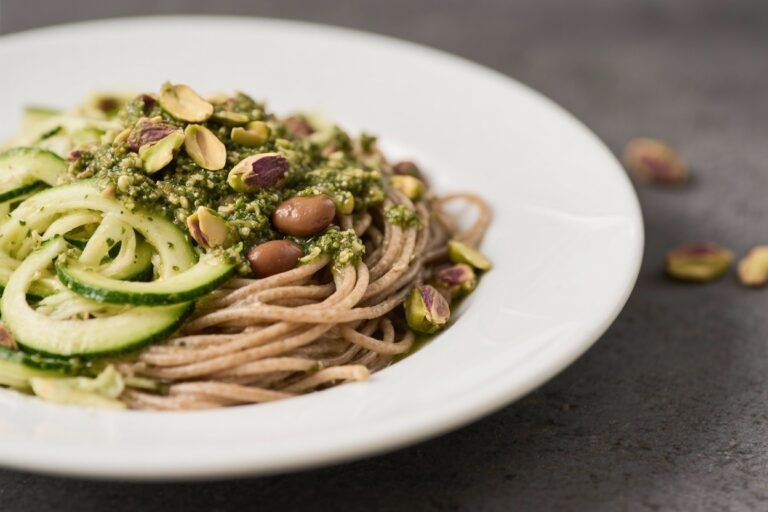Stop Scrolling: Miso‑Glazed Eggplant with Sesame, Scallions; Side of Edamame That Tastes Like a Takeout Glow-Up
You want restaurant-level flavor without paying $18 for vegetables? This is it. Sticky-sweet miso glaze, smoky caramelized eggplant, crunchy sesame, fresh scallions, and a salty side of edamame you’ll demolish before the plate hits the table.
It’s weeknight-simple, date-night-fancy, and meal-prep-friendly. The kind of dish that makes you look like you have your life together—even if you ate cereal for dinner yesterday. Let’s turn humble eggplant into a main character.
Why This Recipe Works
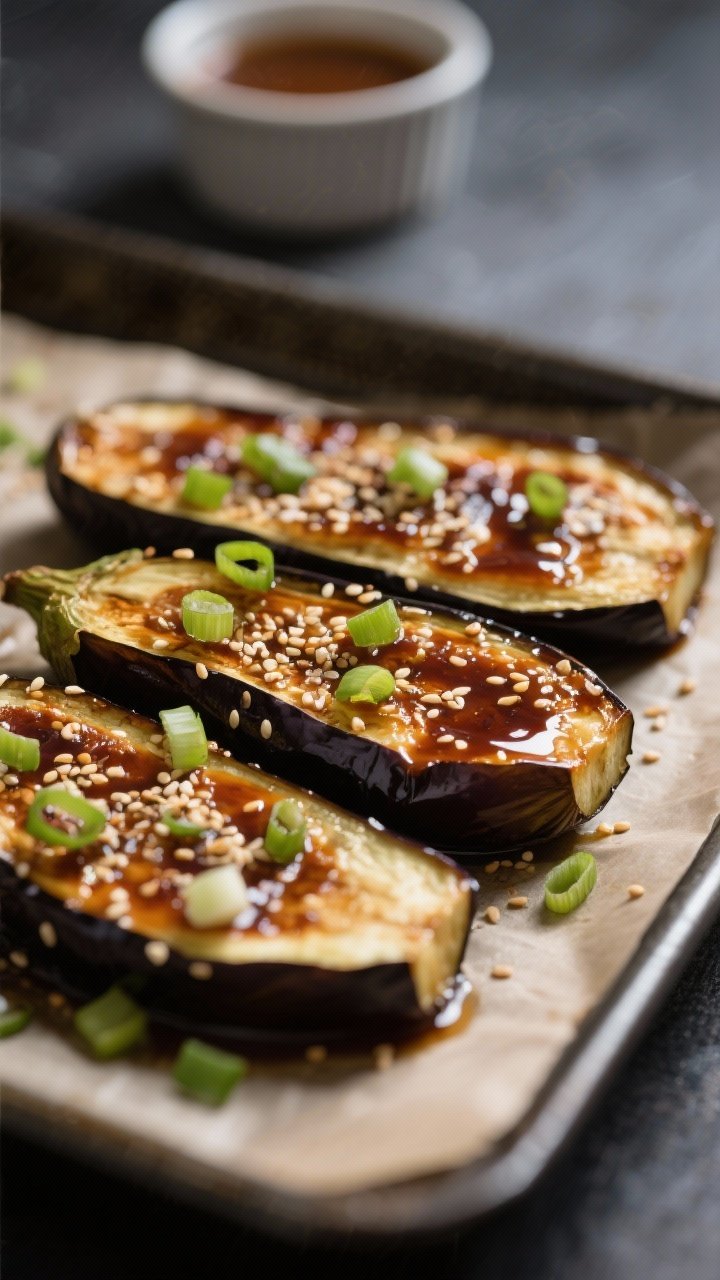
The secret is in the glaze: a balanced mix of miso, mirin, soy, and a touch of sweetness creates deep umami and beautiful caramelization under high heat.
Eggplant acts like a sponge—if you treat it right, it drinks in flavor and turns buttery-soft without going soggy. A quick roast (or broil) gets those edges golden and the insides custardy, while a second glaze application locks in shine.
Sesame seeds add crunch and nuttiness, and scallions bring brightness so the dish doesn’t taste heavy. The steamed edamame on the side?
It’s a protein boost that rounds out the plate and keeps you full. Simple ingredients, huge payoff—no obscure techniques required.
What You’ll Need (Ingredients)
- 2 medium eggplants (Japanese or globe; about 1.5–2 lbs total)
- 2 tablespoons neutral oil (avocado, canola, or grapeseed)
- 2 tablespoons white miso paste (shiro miso; red miso works but will be saltier)
- 1 tablespoon soy sauce (or tamari for gluten-free)
- 1 tablespoon mirin (or 2 teaspoons rice vinegar + 1 teaspoon sugar as a sub)
- 1 tablespoon honey or maple syrup
- 1 teaspoon toasted sesame oil
- 1 small garlic clove, grated
- 1 teaspoon fresh ginger, grated (optional but recommended)
- 1–2 teaspoons water (to thin glaze as needed)
- 2 tablespoons toasted sesame seeds (white, black, or mixed)
- 3 scallions, thinly sliced
- 12–16 oz frozen edamame in the pod (or shelled, your call)
- Coarse salt (for finishing edamame)
- Optional for serving: cooked rice, lime wedges, chili crisp, or shichimi togarashi
Step-by-Step Instructions
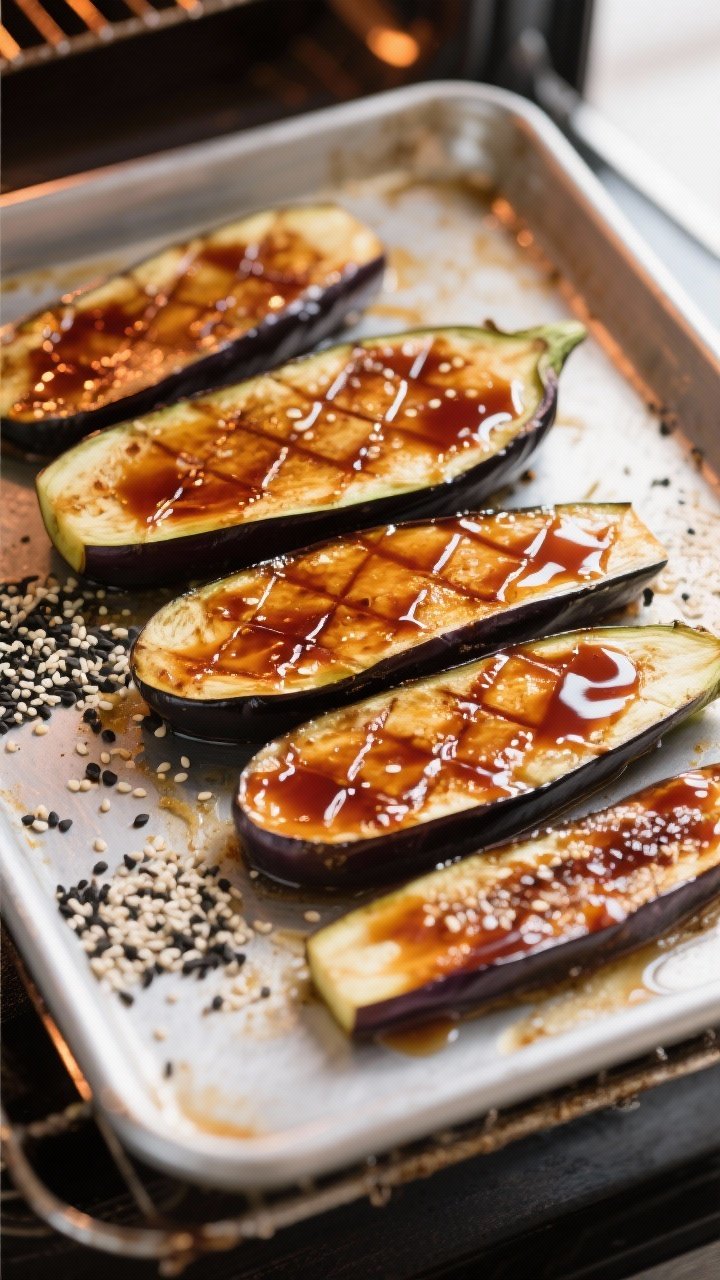
- Preheat and prep. Heat your oven to 425°F (220°C). Line a sheet pan with parchment for easier cleanup.
Wash and dry eggplants.
- Cut the eggplant. For Japanese eggplants, slice lengthwise and score the flesh in a crosshatch pattern without piercing the skin. For globe eggplants, cut into 1-inch half-moons. Scoring = more surface area for glaze to soak in.
- Salt (quickly) and oil. Sprinkle a light pinch of salt over the cut sides, then rub or brush with neutral oil.
Don’t drown it—eggplant loves oil a little too much. Aim for a thin, even coat.
- Roast to tender. Arrange eggplant cut-side up and roast 15–20 minutes, until the flesh is soft and edges are starting to brown. If using half-moons, flip halfway for even color.
- Make the miso glaze. In a small bowl, whisk miso, soy, mirin, honey/maple, sesame oil, garlic, and ginger.
Add 1–2 teaspoons water if it’s too thick to brush. You want glossy and spreadable.
- Glaze round one. Brush a generous layer over the hot eggplant. Return to the oven for 5–7 minutes to caramelize.
Watch closely—sugars can go from wow to whoa-burnt fast.
- Optional broil for lacquer. For that shiny, restaurant-style finish, add a second thin glaze coat and broil 1–2 minutes. Keep the door cracked and eyes on it like it’s a suspicious group text.
- Steam the edamame. While the eggplant finishes, steam edamame according to package directions (usually 4–5 minutes). Toss with coarse salt.
For extra flavor, add a drizzle of sesame oil or a dusting of chili flakes.
- Garnish and serve. Transfer eggplant to a platter, sprinkle with toasted sesame seeds and scallions. Serve with edamame and, if desired, steamed rice, lime wedges, or chili crisp for heat.
Storage Instructions
- Refrigerate: Store eggplant and edamame in separate airtight containers for up to 3 days.
- Reheat: Warm eggplant in a 350°F (175°C) oven for 8–10 minutes or in a skillet over medium heat; add a splash of water to loosen the glaze if needed. Edamame reheats well in the microwave for 30–60 seconds.
- Freeze: Not recommended for eggplant (texture gets mushy).
Edamame can be frozen without issue.
- Make-ahead: The miso glaze can be made 1 week ahead and refrigerated. Stir before using.
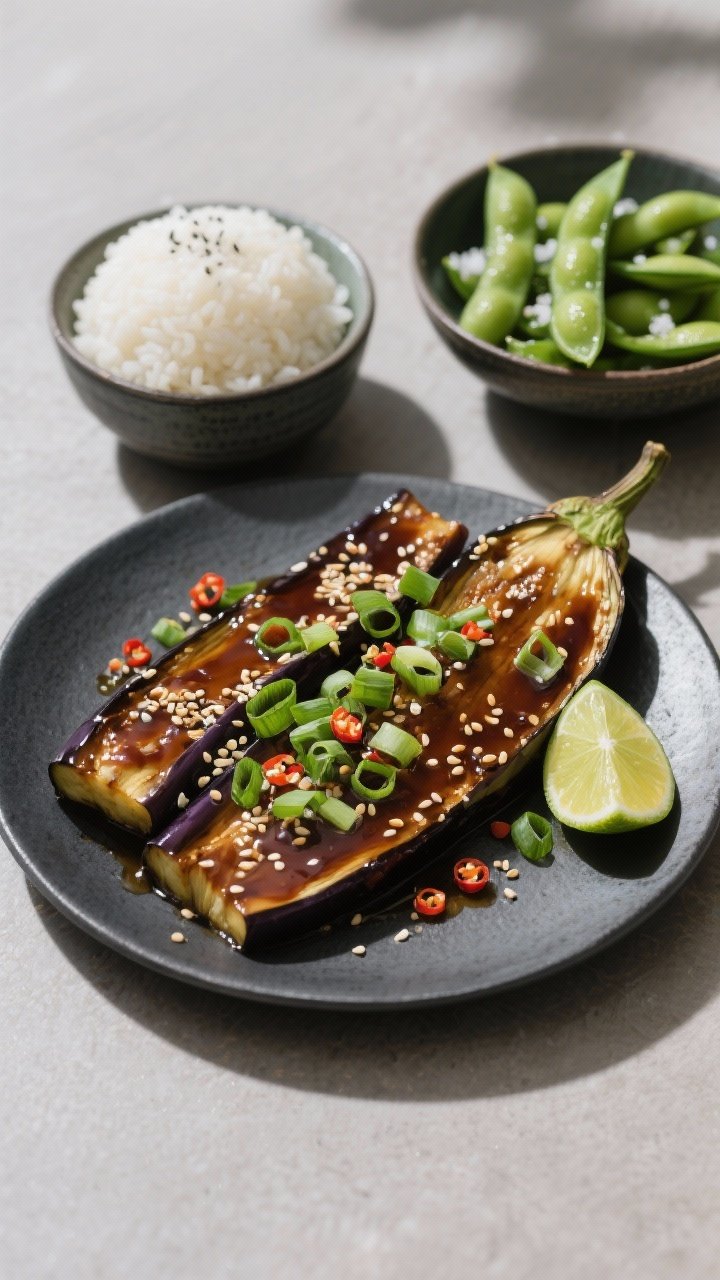
Nutritional Perks
- High in fiber: Eggplant and edamame support digestion and keep you full longer.
- Plant protein: Edamame brings complete protein, making this feel like a satisfying meal, not a side pretending to be dinner.
- Healthy fats: Sesame and a touch of neutral oil add satiety without heaviness.
- Micronutrient boost: Eggplant offers antioxidants like nasunin, while scallions contribute vitamin K and C.
- Lower sodium option: Use low-sodium soy sauce and white miso to keep salt in check, IMO a smart move if you’re sensitive.
Don’t Make These Errors
- Over-oiling the eggplant. It’s a sponge. Too much oil equals greasy, heavy results.
Light brush only.
- Skipping the scoring. No scoring means the glaze sits on top instead of infusing the flesh. You want flavor all the way through.
- Burning the glaze. Sugar caramelizes fast. If broiling, watch like a hawk.
Brown and glossy = yes; blackened = no.
- Using only red miso without adjusting. Red miso is saltier and stronger. Reduce soy sauce or add a splash more sweetener to balance.
- Serving without acid or freshness. Scallions and optional lime wake up the whole dish. Don’t skip the finishing touches.
Mix It Up
- Add heat: Whisk in 1 teaspoon chili paste (gochujang, sambal) or finish with chili crisp.
- Citrus pop: Add 1 teaspoon yuzu juice or lime zest to the glaze for brightness.
- Crunch factor: Top with chopped roasted peanuts or cashews along with sesame.
- Protein upgrade: Serve over a bed of sesame-scrambled tofu or a soft-boiled egg for extra oomph.
- Gluten-free: Use tamari and confirm miso is GF.
Same flavor, zero compromise.
- Grill option: Brush eggplant with oil and grill until tender, then glaze and finish on high heat for smoky vibes.
FAQ
Can I make this with other vegetables?
Yes. This miso glaze loves mushrooms, zucchini, and roasted carrots. Adjust roasting time so veggies are tender before glazing, then caramelize just like the eggplant.
What type of miso is best for this recipe?
White (shiro) miso is mellow and slightly sweet, ideal for glazes.
If you use red miso, reduce soy sauce slightly and add a touch more honey or maple to balance the intensity.
Do I need mirin?
Mirin adds subtle sweetness and body. If you don’t have it, mix rice vinegar with a bit of sugar or honey. Not identical, but close enough that no one will complain.
How do I prevent the eggplant from getting soggy?
High heat, minimal oil, and proper spacing on the sheet pan.
If the pan is crowded, the eggplant steams instead of roasts. Use two pans if needed—worth it.
Can I serve this cold?
Surprisingly, yes. The eggplant tastes great at room temp or chilled, especially in grain bowls with rice or soba.
Add extra scallions and sesame before serving.
What should I serve alongside besides edamame?
Steamed jasmine or brown rice, quinoa, or chewy barley are perfect. A crisp cucumber salad with rice vinegar and sesame oil balances the richness nicely, FYI.
Is this good for meal prep?
Absolutely. Make the glaze ahead, roast the eggplant, and cook a pot of rice.
Assemble bowls with edamame and reheat gently; finish with fresh scallions right before eating.
The Bottom Line
Miso‑Glazed Eggplant with sesame and scallions is the easiest way to turn a simple vegetable into a glossy, umami-packed star. Pair it with salted edamame and you’ve got a complete, protein-rich meal that feels indulgent but cooks fast. Master the glaze, respect the broiler, and let the garnishes do the heavy lifting.
This is the weeknight flex you’ll repeat on purpose.

